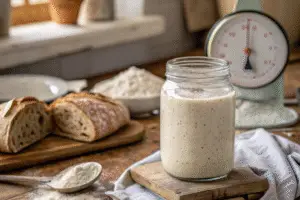Ever notice how the smell of warm butter takes you right back to Saturday mornings in fuzzy socks? That first bite of flaky sourdough croissants—crisp, airy, rich—feels like home and Paris kissed. These homemade beauties are blowing up Pinterest, and for good reason. Sourdough lovers are folding and laminating like pros. Yes, they take time (hello, flaky layers!), but nothing too wild. If you’ve got patience, butter, and a rolling pin, you’re golden.
It’s a cozy sourdough croissant recipe that hugs your soul. Just flour, butter, and magic—plus that tangy starter tucked in like a secret. Stuff you probably already have. Like mom’s Sunday rolls, but trendier and crispier. Full details in the blog!
Learned this one over many chilly mornings with my daughter, cold hands on cool dough, both of us laughing and flour-smudged. Took a few tries—okay, six—but now? Layers that shatter when you bite. No stand mixers, no fuss. I keep it simple. I tested it. You’ll love the secret!
Why You’ll Love This Recipe
Making sourdough croissants might feel ambitious, but trust me, it’s worth every buttery second. The tanginess from the sourdough starter is the star—it elevates the classic croissant into something spectacularly unique. These layers don’t just look fancy; they crumble, flake, and melt with every bite. It’s golden perfection.
At home, this recipe has turned into a weekend tradition. My daughter and I take over the kitchen, rolling, folding, and laughing at the inevitable flour mess. These croissants aren’t just pastries—they’re a memory you can eat.
Pro Tip: Patience is the real secret ingredient here. Let the dough rest, chill, and work its magic. Your future, croissant-eating self will thank you.
Ingredients That Make a Difference

Every ingredient here pulls its weight. The sourdough starter gives you that subtle tangy kick—a flavor you just can’t fake. European-style butter is a game-changer, lending a richness that makes each layer luxurious. And don’t overlook high-protein flour—it adds structure so your croissants rise tall and proud.
If substitutions are needed, here’s a quick guide:
| Ingredient | Substitution |
|---|---|
| European-style butter | Unsalted American butter (though flavor may differ) |
| Strong white flour | Bread flour |
| Whole milk | Plant-based milk (almond or oat for similar texture) |
Note: While substitutions work, sticking with the original ingredients ensures those perfect, bakery-like results.
Step-by-Step Process with Expert Tips
Making these croissants is a two-day process, but don’t let that intimidate you—it’s all about planning. Start with building your dough (the détrempe) and focus on getting it smooth. When incorporating butter during the lamination, always keep that dough cool. If it warms up, you risk butter leakage!
Here’s how I keep the process easy to follow:
| Step | Action | Timing |
|---|---|---|
| Dough Prep | Knead and chill | Day 1: ~3 hours active |
| Lamination | Roll, fold, and chill | Day 1: ~2–3 hours total |
| Shaping & Proofing | Shape into crescents, proof | Day 2: ~4 hours |
Pro Tip: If the dough starts resisting when rolling, pop it in the fridge for 10 minutes to relax.
Troubleshooting and Common Mistakes
A couple of things can trip folks up, but don’t worry—you’ve got this. If your butter starts melting into the dough, it’s likely too warm. Keep everything chilled, and work quickly. On the other hand, if your dough feels too elastic, it’s probably overworked. Let it rest longer between folds so the gluten can relax.
If something doesn’t look perfect, don’t stress—croissants are a learning process. Even if the layers are a little uneven, they’ll still taste incredible.
Pro Tip: Use a high-quality rolling pin for even pressure. A stainless steel one works wonders!
Serving, Storage, and Reheating
Croissants shine when fresh out of the oven, but they can easily be stored or frozen for later. Pair them with homemade jam, or savor their buttery goodness plain alongside coffee. Want to get creative? Try slicing them open and stuffing them with chocolate or almond paste.
To keep leftovers fresh, store baked croissants in an airtight container at room temperature for up to 2 days. For longer storage:
| Storage Method | Reheating |
|---|---|
| Freeze unbaked | Bake straight from frozen, adding 5-10 minutes to bake time |
| Freeze fully baked | Thaw fully, then warm in a 170°C oven for 4-5 minutes |
Pro Tip: Keep a stash of unbaked croissants in your freezer for impromptu weekend treats. Your future self will give you a high five!
Expert Insight: Mastering Flaky Sourdough Croissants
Flaky sourdough croissants achieve their signature layers through careful lamination and the natural acidity of sourdough, which strengthens gluten and enhances texture. This slow fermentation not only deepens flavor but also contributes to a tender, crisp bite that distinguishes them from classic croissants.
For more delicious recipes and cooking inspiration, follow me on Facebook, Pinterest and Reddit!
Perfecting My Flaky Sourdough Croissants
After countless early mornings and a few buttery mishaps, I finally nailed the art of flaky sourdough croissants. Each fold and rest taught me patience and precision, turning this recipe into a treasured family favorite—one that carries the warmth of my kitchen and the stories of many learning curves.
FAQs ( Flaky Sourdough Croissants (Overnight Croissant Recipe) )
How long do I need to proof flaky sourdough croissants?
For flaky sourdough croissants, proofing usually takes about 2 to 4 hours at room temperature until the dough has nearly doubled in size. Since this is an overnight recipe, the bulk fermentation happens slowly in the fridge, which develops flavor and flakiness. Just make sure the dough feels puffy and jiggly before baking!
Can I use regular yeast instead of sourdough starter?
Yes, you can substitute regular yeast if you don’t have sourdough starter, but keep in mind the flavor profile will be different. Sourdough gives a tangy complexity you won’t get with commercial yeast. Use about half a teaspoon of active dry yeast and adjust proofing times accordingly to get your croissants rising beautifully.
How do I achieve the flakiest layers in croissants?
To get those irresistibly flaky layers, laminating the dough carefully is key! Keep your butter cold but pliable, roll the dough evenly, and fold it multiple times to create thin layers. Also, chilling between folds prevents the butter from melting into the dough, ensuring crisp, crunchy layers after baking.
Can I freeze flaky sourdough croissants before baking?
Absolutely! You can freeze shaped croissants before their final proof. Just place them on a baking sheet, freeze until firm, then transfer to an airtight container. When ready, thaw them in the fridge overnight and let them proof before baking for fresh, flaky goodness anytime.
What is the best flour type for flaky sourdough croissants?
Using high-protein bread flour is ideal for flaky sourdough croissants because it provides enough gluten strength to hold those buttery layers together. You can also try a blend of bread and all-purpose flour for a balance of structure and tenderness. Avoid low-protein flours as they won’t develop the right texture.
Wrapping Up Your Flaky Sourdough Croissants
Making these flaky sourdough croissants is truly a joy — a little patience turns simple kitchen ingredients into buttery, layered magic. You’ll love how the tangy starter and crisp layers come together, giving your homemade baking that bakery-wow factor without the fuss.
Feel free to mix it up: add a sprinkle of cinnamon sugar before baking, swap European butter for a local favorite, or stash extras in the freezer for busy mornings. Here’s a tip from a pro baker friend — always chill dough between folds for those perfect, flaky layers.
Now it’s your turn: did you make these with family or friends? Snap a pic, share your twists, or pass this recipe along to someone who’d adore it. Because nothing says love quite like warm croissants fresh from your own oven.
PrintFlaky Sourdough Croissants
Enjoy flaky and buttery Overnight Sourdough Croissants that capture the authentic taste of Parisian viennoiserie. This two-day recipe creates perfect layers and a golden, crispy crust.
- Prep Time: 3 hours
- Cook Time: 20 minutes
- Total Time: 1 day 3 hours 20 minutes
- Yield: 12 small(ish) croissants 1x
- Category: Breakfast, Pastry
- Method: Baked
- Cuisine: French, Sourdough
Ingredients
- For Détrempé:
450 g strong white flour
¾ teaspoon salt
40 g caster sugar
130 ml water
90 ml milk
150 g active sourdough starter 100% hydration
50 g unsalted butter room temperature
For Lamination:
250 g unsalted butter room temperature
For Egg Wash:
1 egg yolk + 1 tablespoon milk (or double cream)
Instructions
- DAY 1:
First thing in the morning, feed your starter and leave it a warm spot to at least double in size. This should happen within 4 hours in 20-22°C temperature. If it takes longer than that, you may need to feed your starter again, to ensure it’s active and not too acidic to make great croissants.
Make Détrempé:
Place the flour, salt, sugar, water, milk and active sourdough starter in a bowl of your stand mixer, fitted with a dough hook attachment. Turn the stand mixer on and knead for 5 minutes on medium speed until the dough comes together into a rough (rather stiff) ball. leave the dough to relax for 15 minutes.
After 15 minutes, turn the stand mixer on again on medium speed, and start adding 50g of room temperature butter a little bit at a time. Keep the mixer running for around 8-10 minutes until the butter is fully incorporated and you have a smooth dough. It shouldn’t be sticky.
Shape a ball, slash the dough with a sharp knife in a cross on top of the dough and place the dough in a lightly greased bowl. Cover and leave in a warm spot to bulk prove for approx. 4 hours at 21-23°C until risen 1.5 times. Place the dough in the fridge for another 3-4 hours to finish proving and double in size.
Laminate:
Take the butter out of the fridge in advance to soften slightly. Place it on a large sheet of baking parchment, place another sheet of parchment on top. Using a rolling pin, gently bash to flatter the butter. Fold the baking parchment under into a neat 18x18cm square and roll the butter inside the parchment parcel to the same thickness. Place the butter in the fridge to firm up.
Take the dough out of the fridge and roll it on a floured surface into a 28x28cm square. Unwrap the butter (keep the baking parchment). Place the butter diagonally in the middle of the dough.
Fold each side of the dough towards the center, creating a butter parcel sized about 20x20cm. Wrap and freeze for 10 minutes.
First Fold: Roll the parcel into a 50x20cm rectangle. Trim edges. Fold like a letter (fold one third, then the opposite third over). Wrap and freeze for 15 minutes, then fridge for 1 hour.
Second Fold: Roll out again to 50x20cm. Fold thirds as before. Wrap and freeze for 15 minutes, then fridge for 1 hour.
Third Fold: Roll out to 50x20cm. Fold like a letter. Wrap and place in fridge for minimum 6 hours or overnight.
DAY 2:
Shape Croissants:
Roll pastry to 60x28cm, trim sides. Cut 6 rectangles approx. 10x28cm. Cut each rectangle diagonally to create 12 triangles.
Trim bottoms to straight edges. Make a small cut in bottom center and stretch slightly.
Roll triangles from bottom to tip and bend ends into crescent shape.
Place shaped croissants spaced on two baking parchment lined trays. Cover lightly with oiled cling film. Proof in a warm spot (21-23°C) for 4-5 hours until puffed.
For dry or cold climates, create steam in oven to maintain humidity under 23°C.
Remove cling film and chill croissants in fridge for 20 minutes.
Egg Wash & Bake:
Preheat oven to 190°C Fan.
Whisk egg yolk and milk. Gently brush croissants.
Bake for 20-25 minutes. Cool at least 15 minutes before serving.
Notes:
Freeze Unbaked Croissants: Freeze shaped and proofed croissants on tray for 2 hours, then store in ziplock bags. Bake at 190°C Fan for 25-30 minutes from frozen.
Freeze Baked Croissants: Cool, freeze in single layer. Thaw completely and reheat at 170°C Fan for 4-5 minutes before serving.
Notes
- If you cannot eat all 12 croissants within a couple of days, freeze unbaked croissants after proofing or freeze baked croissants for later
- Follow reheating instructions for best results
Nutrition
- Serving Size: 1 small(ish) croissant
- Calories: 343 kcal
- Sugar: 4 g
- Sodium: 153 mg
- Fat: 21 g
- Saturated Fat: 13 g
- Unsaturated Fat: 6 g
- Trans Fat: 1 g
- Carbohydrates: 33 g
- Fiber: 1 g
- Protein: 5 g
- Cholesterol: 54 mg











